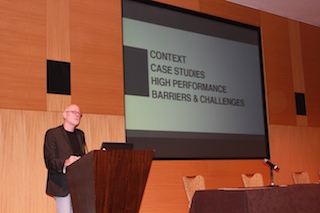
Features
Community
Event reports
Mic Patterson gives keynote address on façade technology and applications at 2015 AAMA Summer Conference
July 8, 2015 By AAMA

July 8, 2015 – Author and researcher Mic Patterson addressed the audience at the 2015 American Architectural Manufacturers Association (AAMA) Summer Conference, held June 28-July 1, in Seattle. Patterson’s keynote address at the event reviewed the recent evolution in façade technology and applications. He identified current and emerging drivers that are powering this change and discussed the challenges and opportunities now facing the glass industry.
Patterson discussed some of the drivers of change, such as geometric complexity, material and process diversity, and acoustical performance. “Most projects referred to as high performance have little to do with performative considerations, but are largely driven by appearance,” he said.
“The building skin combines considerations of performance and appearance like no other building system,” explained Patterson in his address.
Performance considerations typically focus on operational energy consumption and new construction. However, Patterson implored, “it’s not all about energy — adaptability, durability and recyclability should all be considered, as well. Beyond that, it’s not even just about operational energy. Factors like embodied energy, embodied energy debt, maintenance, renovation and end-life disposal are all crucial.”
His presentation also defined differential durability as a measure of performance over time in a specific environmental context. “Materials and service life matter,” said Patterson. He encouraged those in attendance to think about environmental impacts and the impact of your carbon footprint as well as cost.
“Our markets, our products, our systems — the built environment — are ripe for transformation,” said Patterson. “This presents both opportunity and threat.”
However, there are other factors to consider. “Barriers to adoption of high-performance green façade technology include energy, cost, energy prices, building standards and codes, innovation, risk aversion, integration and other factors,” said Patterson.
“We are building our future problems today,” he concluded.
For more information
www.aamanet.org
Print this page